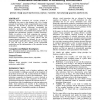527 search results - page 34 / 106 » Design beyond human abilities |
HUC
2010
Springer
13 years 8 months ago
2010
Springer
With a focus on presenting information at the right time, the ubicomp community can benefit greatly from learning the most salient human measures of cognitive load. Cognitive load...
AVI
2004
13 years 9 months ago
2004
Designing effective instructions for everyday products is challenging. One reason is that designers lack a set of design principles for producing visually comprehensible and acces...
ECAL
1995
Springer
13 years 11 months ago
1995
Springer
Neither `design' nor `evolutionary' approaches to building behavior-based robots feature a role for development in the genesis of behavioral organization. However, the n...
IROS
2006
IEEE
14 years 1 months ago
2006
IEEE
— For humanoid robots which are able to assist humans in their daily life, the capability for adequate interaction with human operators is a key feature. If one considers that mo...
ICRA
2008
IEEE
14 years 2 months ago
2008
IEEE
— How to teach actions to a robot as well as how a robot learns actions is an important issue to be discussed in designing robot learning systems. Inspired by human parentinfant ...

